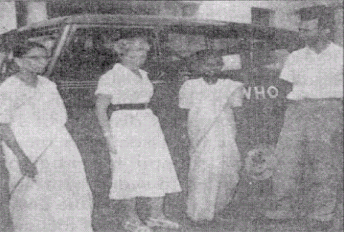| 034 |
| AU |
: |
Andersen S & Banerji D |
| TI |
: |
Report on a study of migration in four taluks of Bangalore
district. |
| SO |
: |
POPULATION REVIEW 1962, 7, 69-72. |
| DT |
: |
Per |
| AB |
: |
The purpose of the study was to establish the rate
of emigration in a random selection of villages, with a view to
forecast the likely loss of population in a follow-up study on BCG
vaccination in the area. The study was carried out in the total
population belonging to 35 villages of Channapatna, Devanahalli,
Magadi and Nelamangala taluks of Bangalore district in April 1960.
Demographic characteristics such as birth and death rates, immigration
rates and proportion of persons temporarily absent, were also studied.
The head of the household if absent, any other responsible adult
was interviewed on a house-to-house basis, regarding the composition
of the family, according to the NTI manual for census takers. Estimation
of migration was to be based on the registered population of the
current day, the population exactly one year ago and all relevant
events during the intervening year.
The thirty five villages surveyed were found to
have a population of 13,838 persons at the time of interview. This
figure included: (A) 13138 persons in the household at the time
of census taking also belonged to it one year ago. (B) 470 persons
born during the past year. (C) 230 persons immigrated during the
past year. (D) 200 persons dead during the past year. (E) 307 persons
emigrated during the past year & (F) 770 persons temporarily
absent. The net increase in the population from April 1959 to April
1960 was, 193 persons or 14 per thousand.
It was estimated that not more than 5% of the population
would be lost by emigration over a period of two years. About 1/3rd
of the emigration is within the same taluk. Only a small portion
of the emigrants are above 30 years of age. It is also found that
a good proportion of women's migration is due to marriage. The study
findings revealed that the hypothesis that large number of people
leave the village every year, making BCG coverage impossible could
hardly be upheld.
|
| KEYWORDS: SOCIAL DEMOGRAPHY; SOCIAL RESEARCH; INTERVIEWING;
MIGRATION; INDIA. |
